Sustainable balcony vegetable gardening is a practice that allows individuals to grow their food in limited space while minimizing environmental impact. It involves using eco-friendly techniques and materials to create a self-sustaining garden on your balcony or terrace. Sustainable balcony vegetable gardening allows you to grow fresh produce and contributes positively towards reducing food waste, promoting biodiversity, and creating green spaces amidst concrete jungles.
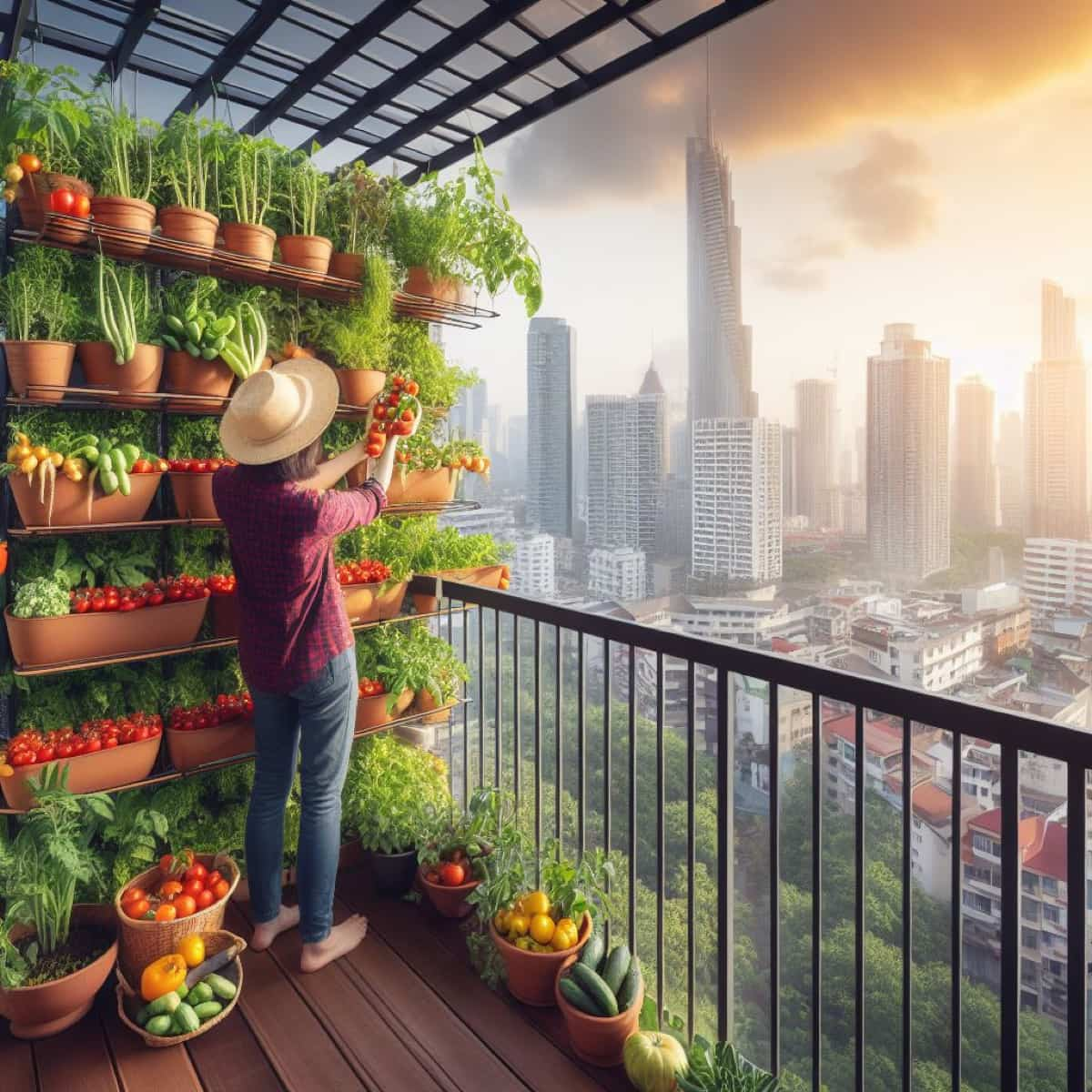
Sustainable Balcony Vegetable Gardening
Choosing the Right Containers for Balcony Vegetable Gardening
| Size | The container size should be appropriate for the plant’s root system. Larger plants require bigger containers to allow their roots to spread and grow. |
| Material | Containers can be made from plastic, terracotta, or fabric bags. |
| Drainage | Ensure that your chosen container has proper drainage holes to prevent waterlogging, which can lead to root rot. |
| Weight | Consider the weight of the container as well since balconies have weight restrictions. |
| Aesthetics | Choose containers that complement your balcony’s overall design aesthetic while being functional for growing vegetables. |
Selecting Suitable Vegetables for Balcony Gardening
Some popular choices for Sustainable balcony vegetable gardening include Cherry Tomatoes, Peppers, Lettuce, Spinach, herbs like Basil and Parsley, and smaller root vegetables like Radishes and Carrots. These vegetables are not only well-suited for container planting but also offer a variety of flavors and nutritional benefits. It’s important to select vegetables that match the sunlight your balcony receives throughout the day.
In case you missed it: Top 12 Attractive Foliage Plants for a Sunny Balcony Garden
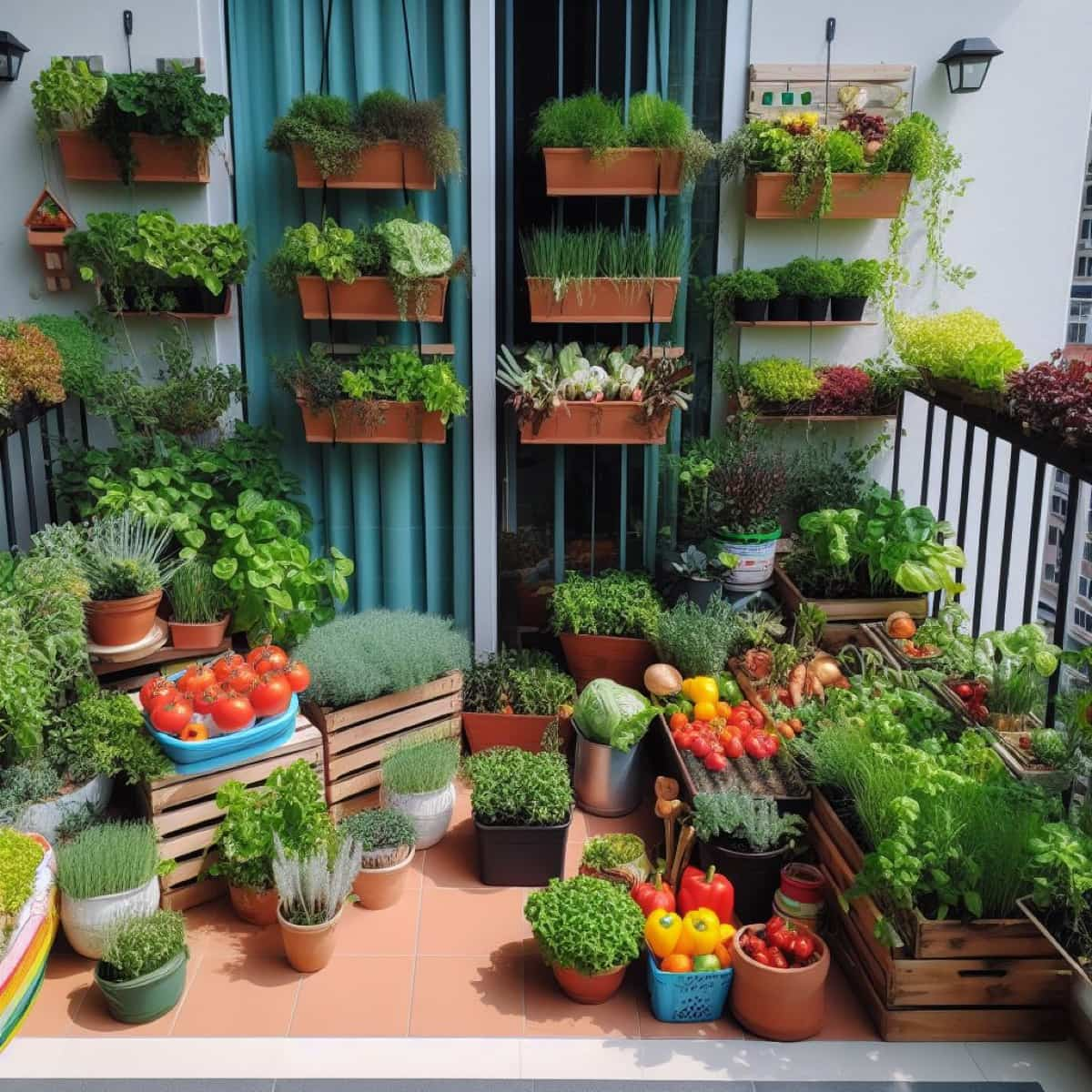
Some plants prefer full sun exposure, while others can tolerate partial shade. Considering these light requirements will help ensure the success of your vegetable garden. Additionally, consider the climate in which you live when choosing vegetables for a balcony garden. Certain plants may be better suited for cooler or warmer climates. Researching which varieties perform best in your region will increase the chances of a bountiful harvest.
Understanding the Importance of Soil Quality in Balcony Vegetable Gardening
| Composition | A combination of potting mix, compost, and perlite is often recommended to ensure proper water retention without becoming compacted. |
| Nutrient Content | Balcony gardens require nutrient-rich soil as potted plants have limited access to natural sources like organic matter or beneficial microorganisms in traditional garden beds. |
| pH Level | Adjusting the pH level with dolomite lime or sulfur additives can improve plant growth and nutrient uptake. |
| Drainage Capability | Ensure your containers have adequate drainage holes, and add a gravel layer at the bottom before filling them with soil. |
| Renewal | Over time, the nutritional content of balcony garden soils may be depleted due to continuous cultivation cycles. To maintain optimal fertility, replenishing the growing media by replacing old soil every few years helps provide fresh nutrients that support vigorous plant growth. |
Implementing Proper Drainage Systems for Balcony Gardens
Implementing proper drainage systems is crucial for sustainable balcony vegetable garden success. Excess water can accumulate in the containers without adequate drainage, leading to root rot and other problems. Check your container’s drainage holes at the bottom. This allows excess water to flow freely and prevents it from getting trapped in the soil. Additionally, placing a layer of gravel or small stones at the bottom of your containers can further improve drainage.
Next, use well-drained soil mixtures that provide good aeration for the roots. Avoid heavy soils that retain too much moisture, and opt for lightweight potting mixes. Another important step is to monitor watering carefully. Overwatering is one of the main causes of poor drainage in container gardens. Water only when needed, and make sure not to let water accumulate on top of saucers or trays beneath the pots. Consider elevating your containers slightly using bricks or blocks to allow even better airflow and prevent waterlogging during heavy rainfalls.
Providing Adequate Sunlight for Balcony Vegetable Plants
Regarding Sustainable balcony vegetable gardening, providing adequate sunlight for your vegetable plants is crucial for their growth and productivity. Sunlight is plants’ primary energy source, enabling them to carry out photosynthesis and produce food. Without sufficient sunlight, your plants may become weak, leggy, or fail to thrive altogether.
In case you missed it: How to Create a Beautiful Flower Garden in the Balcony
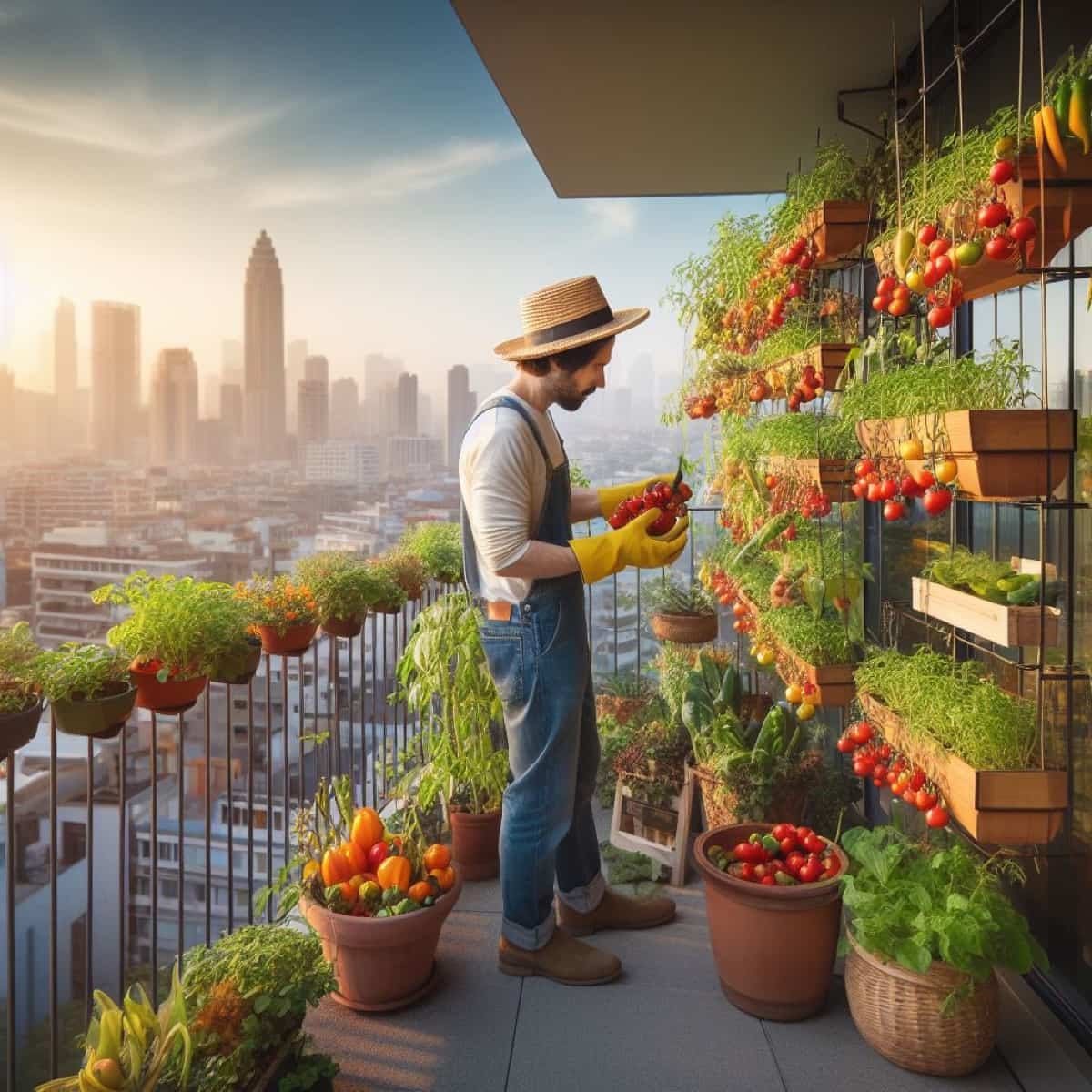
Choose a location that receives 6-8 hours of direct sunlight daily to ensure that your balcony garden receives enough sunlight. Remember that different vegetables have varying light requirements – some prefer full sun while others can tolerate partial shade. If your balcony has limited access to natural sunlight, consider using supplemental lighting such as grow lights or LED lamps. These artificial light sources can provide the wavelengths of light plants need for photosynthesis.
Watering Techniques and Irrigation Systems for Balcony Gardens
Watering is a crucial aspect of balcony vegetable gardening, as it directly affects the health and growth of your plants. However, with limited space and resources, it’s important to implement efficient watering techniques and irrigation systems to ensure optimal moisture levels for your plants. One effective technique is hand-watering using a watering can or hose.
This allows you to control the amount of water each plant receives and target specific areas that may need more hydration. Another option is drip irrigation, which delivers water to the roots of your plants through tubes or hoses with tiny holes. This method ensures minimal water wastage by delivering water precisely where needed. For those who prefer automated systems, consider installing a timer-controlled irrigation system.
These systems can be set up to deliver water at specific intervals throughout the day, ensuring consistent moisture levels without the need for constant manual intervention. Incorporating self-watering containers into your balcony garden can help maintain optimal moisture levels. These containers have built-in reservoirs that store excess water and gradually release it as the plants need.
Utilizing Organic Fertilizers and Compost in Balcony Gardening
When it comes to balcony gardening, utilizing organic fertilizers and compost is crucial for the health and productivity of your plants. Organic fertilizers provide essential nutrients that promote growth and strengthen the overall resilience of your vegetable garden. Conversely, compost enriches the soil with organic matter, improving its structure and moisture retention capabilities.
One popular organic fertilizer option is vermicompost, created by feeding kitchen scraps to worms. This process produces nutrient-rich castings that can be used as a top dressing or mixed into potting soil. Another effective choice is fish emulsion, made from fermented fish waste. In addition to these commercial options, you can make organic fertilizer using everyday household items like coffee grounds and eggshells. Coffee grounds deter slugs and snails, while crushed eggshells provide calcium for strong plant development.
Managing Pests and Diseases in a Sustainable Manner
| Companion planting | By interplanting certain vegetables and herbs, you can naturally deter pests. |
| Natural predators | By interplanting certain vegetables and herbs, you can naturally deter pests. For example, marigolds repel aphids while attracting beneficial insects like ladybugs. |
| Crop rotation | Rotate your crops each season to minimize pest and disease problems. This helps break the life cycle of pests that may overwinter in the soil. |
| Organic sprays | Homemade sprays made from ingredients like neem oil or garlic can be effective against common garden pests and safe for humans and the environment. |
| Regular inspection | Check your plants for symptoms of infestation so you can act before it becomes a bigger issue. |
| Proper sanitation | Remove any diseased plant material promptly to prevent the spread of diseases to other plants. |
In case you missed it: Balcony Grill Garden Ideas: Small Spaces, Apartments, and Best Plants to Grow on Grills
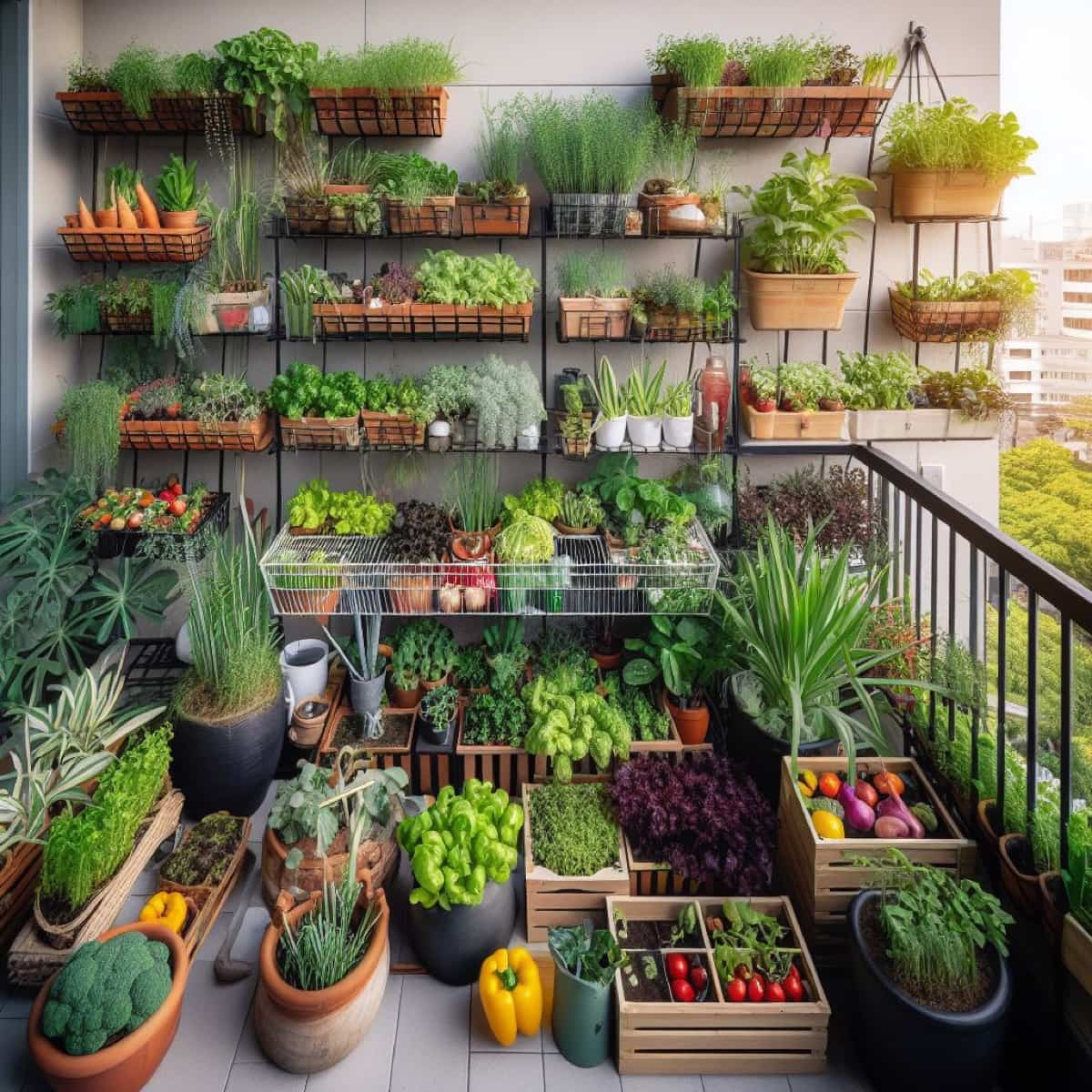
Companion Planting Strategies for Balcony Vegetable Gardens
Creating a harmonious plant community on your balcony is aesthetically pleasing and benefits your vegetable garden’s overall health and productivity. Companion planting involves strategically placing different plants together to enhance their growth and deter pests.
| Basil and Tomatoes | The aromatic oils produced by Basil help repel insects that often attack Tomato plants. Plus, these two companions share similar sunlight and watering requirements, making them ideal bedfellows. |
| Marigolds and Cucumbers | Marigolds release chemical compounds that deter harmful nematodes from attacking Cucumber roots. Additionally, Marigolds attract beneficial pollinators like bees, promoting better Cucumber fruit sets. |
| Nasturtiums and Beans | Nasturtiums act as a natural trap crop by attracting aphids away from Bean plants with their vibrant flowers. |
| Chives and Carrots | Chives emit an odor that repels carrot flies, protecting your Carrots from potential damage while adding a delicious Onion-like flavor to dishes when harvested. |
Pruning and Training Techniques for Compact Growth in Limited Spaces
Pruning and training techniques are essential for compact growth in limited spaces, such as balcony gardens. By strategically pruning and training your vegetable plants, you can maximize their productivity while keeping them manageable and visually appealing. One effective technique is called pinching. This involves gently pinching off the tips of young shoots to encourage bushier growth.
It helps prevent leggy plants that may take up too much space. Another method is thinning, which involves removing excess foliage or overcrowded branches to improve airflow and light penetration. Training techniques like trellising or staking can also benefit small garden spaces. By supporting climbing vegetables like Tomatoes or Cucumbers, you can help them grow vertically rather than sprawling horizontally.
Vertical growth not only saves space but also makes harvesting easier. Regularly monitoring your plants’ growth and adjusting their position is crucial for compact gardening success. Prune away any dead or diseased foliage promptly to prevent the spread of diseases, ensuring healthier plant development overall.
Harvesting and Preserving the Yield from Balcony Gardens
Once your balcony garden yields a bountiful harvest, it’s time to celebrate all your hard work. Make sure you harvest at the right time. Each vegetable has its specific harvesting window, so pay attention to signs like color, size, and texture. Don’t rush or wait too long – timing is crucial for optimal flavor. After gathering your produce, handle them gently to avoid bruising or damaging them. Using a sharp pair of pruning shears for a clean cut is better than yanking or twisting them off.
In case you missed it: How to Grow Broccoli in Pots in India: at Home, on the Terrace, in the Backyard and Balcony
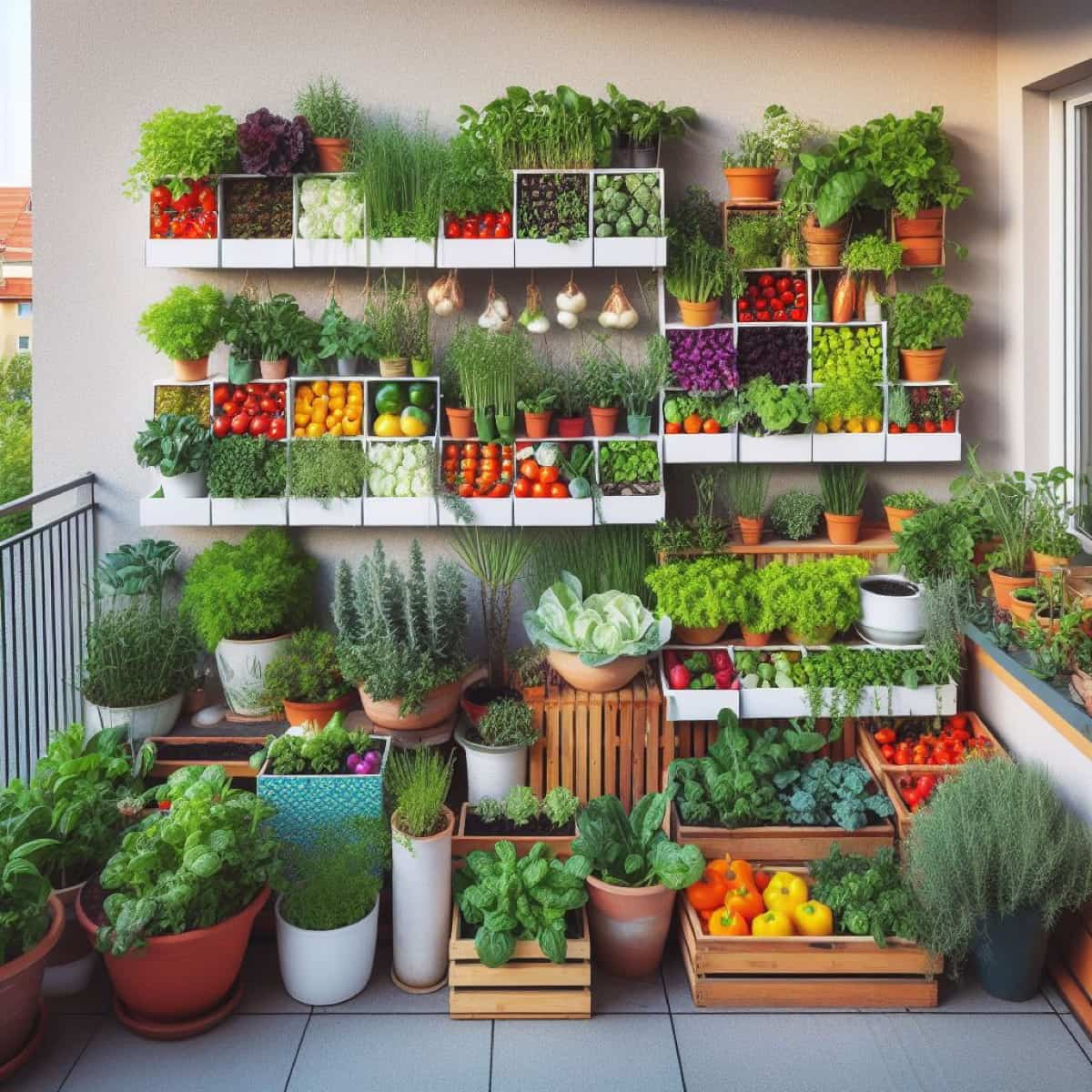
Preserve your bounty by freezing or canning. Blanching vegetables before freezing helps retain their freshness and nutrients. For canning, follow proper sterilization techniques to ensure safety. Another great way to preserve harvested herbs is by drying them. Hang bundles upside down in a well-ventilated area until they are completely dried out; then, store them in sealed jars for future use.
Recycling and Reusing Materials in Balcony Gardening Practices
Recycling and reusing materials are not only environmentally friendly practices, but they can also be incredibly beneficial in balcony gardening. One simple way to recycle materials is using old containers or buckets as planters. Just make sure to drill drainage holes if needed. You can also repurpose wooden pallets into vertical gardens or use them as a base for raised beds.
Broken terracotta pots can be transformed into quirky mini gardens or used for drainage at the bottom of larger containers. Instead of throwing away organic waste, create your nutrient-rich compost by recycling kitchen scraps, coffee grounds, and yard trimmings. This homemade compost will nourish your plants and reduce the need for chemical fertilizers.
Promoting Biodiversity and Attracting Beneficial Insects to Balconies
Creating a sustainable balcony garden is about growing your food, promoting biodiversity, and attracting beneficial insects. By incorporating certain practices into your gardening routine, you can make an environment that supports the ecosystem and enhances the overall health of your plants. One way to promote biodiversity is by choosing a variety of plant species for the balcony garden.
Opt for native plants, which are well-adapted to the local climate and provide essential food sources for native insects and birds. Mix flowering plants with herbs and vegetables to attract a diverse range of pollinators. Avoid using chemical pesticides in your balcony garden. These chemicals harm beneficial insects and disrupt the delicate balance of nature. Instead, choose organic pest control methods like companion planting or introducing natural predators like ladybugs or praying mantises.
In case you missed it: How to Create a Low-Maintenance Home Garden in India: Designing and Practices
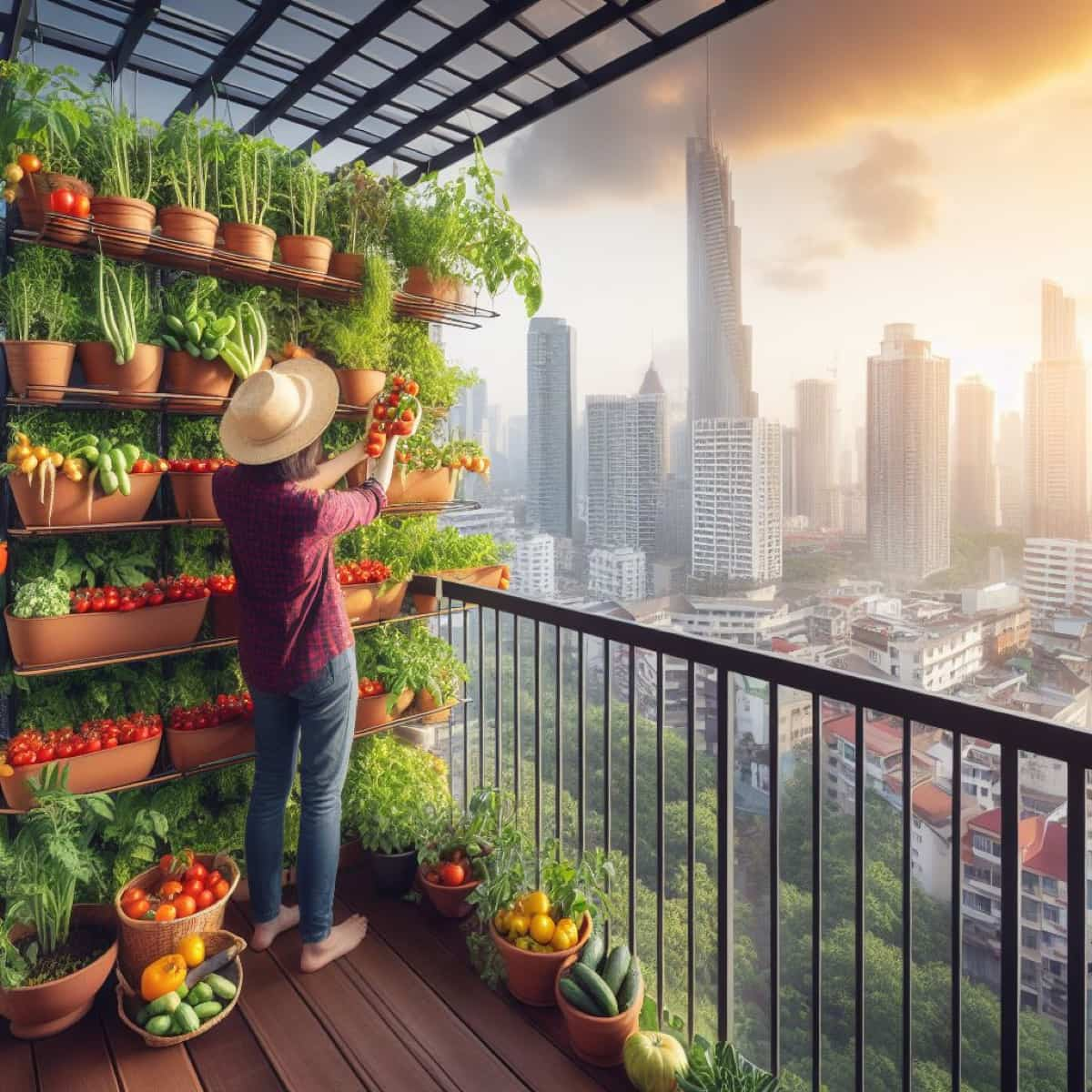
Conclusion
Creating a sustainable balcony vegetable garden is a rewarding experience and an excellent way to contribute towards a healthier environment. Remember to choose the right containers and soil, invest in essential gardening tools, carefully select your plants and seeds, and maintain a healthy garden through proper watering, fertilizing, and pest control.
With these practices in place, you’ll be well on your way to enjoying a bountiful harvest of homegrown vegetables. Also, don’t be afraid to get creative with small-space gardening techniques on the balcony. Vertical gardens, hanging baskets, and trellises are just some ideas that can maximize limited space while adding beauty to your surroundings.
- Flower Garden Designs and Layouts for Beginners
- Planting and Spacing Techniques in Papaya: A Beginner’s Guide
- Growing Gold: Essential Techniques for Planting Pineapples
- How to Make Kalanchoe Plant Bushy: Home Remedies and Solutions
- 11 Reasons Why Your Gardenia is Not Blooming: Home Remedies and Solutions
- Eco Elegance: The Guide to Designing a Drought-Tolerant Landscape
- Gardening on a Slope: Strategies for Hillside Landscaping
- Nourish and Flourish: Top Organic Mulches for Thriving House Plants
- Everything You Want to Know about Indian Mogra Flower: Discover Uses and Growing
- Green Thumb Success: Expert Tips for Cultivating Greenhouse Pumpkins All Year Round
- Maximize Growth & Flavor: The Ultimate Guide to Companion Planting in Herb Gardens
- How to Control Rhododendron Problems Naturally: Home Remedies and Organic Ways to Fix Them
- Natural Magic: The Remarkable Benefits of Cinnamon for Plants
- Best Steps to Revive Dying Tulip with Natural and Organic Treatment
- 10 Reasons Why Your Angel Trumpet is Not Blooming: Remedies and Treatment
- How to Fix Periwinkle Leaf and Flower-Related Problems: Natural Remedies and Solutions
- How to Fix Zinnias Leaf and Flower Problems: Discover Natural and Home Remedies
- Organic Steps to Induce Lemon Tree Flowers: A Comprehensive Guide
- Bloom Booster: Crafting the Perfect Homemade Bougainvillea Fertilizer
- Optimizing Growth: A Guide to Applying NPK Fertilizer for Potted Plants
- 10 Best Homemade Fertilizers for Rubber Plant: DIY Recipes and Application Method
- How to Boost Female Pumpkin Flowers: Effective Steps for More Flowers and High Yields
- Transform Your Indoor Garden: Top Benefits of Pink Salt for Houseplants
- 10 Best Homemade Fertilizers for Peacock Plants (Calathea): Easy DIY Guide
- Unlock Blooms: 9 Reasons Why Your Potted Chrysanthemum is Not Blooming
- 8 Reasons Why Your Potted Hibiscus is Not Blooming: Fix it with Simple Solutions
- Unlock Blooms: 9 Key Reasons Your Potted Frangipani Won’t Flower
- 10 Reasons Why Is My Ice Plant Not Blooming: Remedies and Treatment
- 10 Reasons Why My Potted Hydrangea Not Blooming: Treatment and Remedies
- 10 Reasons Why is My Wisteria Not Blooming: Remedies and Treatment
- 10 Reasons Why is My Goldfish Plant Not Blooming: Remedies and Treatment
- Maximize Your Space: Ultimate Guide to Balcony Gardening with Grow Bags
- 10 Reasons Why Your Iris is Not Blooming: Remedies and Treatment
- 10 Reasons Why Your Anthurium Plant is Not Blooming: Treatment and Remedies
- 10 Reasons Why Your Aquaponic Plants Are Not Flowering: Remedies and Treatment
- 10 Reasons Why Your Agapanthus is Not Flowering: Remedies and Treatment